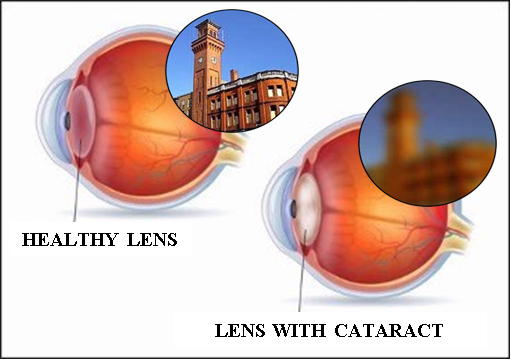News
Blog
CATARACT
is a condition characterized by loss of transparency or clouding of the natural crystalline lens. The primary function of the natural crystalline lens is to focus the light entering the eye onto the retina thereby giving us the ability to see.

Cataracts often develop slowly with a decrease in vision and may lead to eventual blindness if left untreated. You can develop cataract in one or both eyes and the severity or grade of cataract can differ between both eyes. A common misconception is that cataract can spread from one eye to another, which is absolutely FALSE.
What are the causes for cataract?
The most common cause of cataract is aging. The changes in crystalline lens begin around the age of 40 years and over time result in cataract. However, you can develop cataract at an early age due to certain causes/risk factors like diabetes, eye injury, chronic eye inflammation, excessive use of steroids (tablets/ injections), excessive exposure to sunlight (UV radiation), smoking, genetic predisposition, prior ocular surgery, and exposure to radiation. Cataract can occur in infants and children too. This can be due to genetic disorders, infections, metabolic disorders, injuries. However, in most of the children the cause is unknown (idiopathic).
Age-related cataracts progress gradually, however, cataract due to other causes can progress at a quicker pace and it is difficult for the doctor to predict how quickly it happens. So it advisable to undergo regular eye examinations to evaluate the cataract progression.
Can I delay the cataract onset?
Yes, the onset of cataract can be delayed to a certain extent by wearing sunglasses (UV protective), having a healthy diet [plenty of vegetables and fruits, food rich in antioxidants (spinach, carrot, green tea and kale etc)], quitting smoking, strict control of diabetes.

What are the symptoms of cataract?
You might not experience any symptoms in the early stages of cataract. However, as the cataract progresses you might experience one or more of the symptoms mentioned below:
- You might experience blurring of vision which is gradual
- Difficulty reading in dim lit rooms
- You might have poor night vision
- You might see bright circles or rings around light source(haloes)
- You might feel lamps, sunlight or headlamps are too bright (glare)
- You can have double vision
- You might have to change your glasses frequently
- You might perceive colors differently.A new ability to read without reading
- Glasses(sight) due to changes in refractive status of the eye.
- You might have visual loss in advanced stages.

Please note that these symptoms can be a sign of other ocular conditions too. Get yourself evaluated with an ophthalmologist if you experience any of these symptoms.
How to determine if I have developed cataract?
An ophthalmologist will examine your eyes to diagnose cataract. As a part of this evaluation the doctor will check your vision, intraocular pressure and instill dilating drops in your eyes to widen your pupil (an opening that allows the light to enter the eye) and examine the eye in toto.
What is the treatment for cataract?
As on date there is no medical treatment to prevent the development or progression of cataracts, neither can medical management reverse the cataractous changes.
In the early stages, cataract can be temporarily managed by using bright light while reading and other activities, obtaining a new glass prescription to have a better visual acuity, limit driving especially if symptoms of glare and haloes are bothersome.

When the cataract has progressed to a stage where your routine daily activities are compromised then planning for cataract surgery becomes a necessity. Modern cataract surgery involves removal of the cloudy lens and implantation of an artificial clear lens known an intraocular lens (IOL).
Are there any complications associated with cataract surgery that I should know of?
Cataract surgery is considered to be one of the safest eye surgery. However, in complicated cataract scenarios even with all the best precautions there can be few rare complications such as recurrent inflammation of the eye, corneal swelling, break in the capsular bag where the IOL has to be placed, weak capsular bag, IOL dislocation and very rarely infection. In such an event the surgeon will take all necessary steps to overcome the complication and provide you with the best possible outcome.


